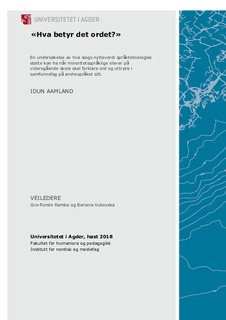| dc.description.abstract | The topic of this master thesis is wordlearningand receptive wordcomprehension among the minority language students in high school who have lived shortly in Norway. Through a study in an introductory class at a high school in Aust-Agder, I have looked at the use and benefit of digital language support of the mother tongue and the second language in the students' work with wordsfrom a textbook in Norwegian in social studies. The main research questionis“Whatbenefitcan digital languagesupport have when minority language students explain the words in thesecond language?”.The purpose of this thesis is to look at whether the use of digital language support of the mother tounge, such as the use of the Google Translate application and language-based support of the second language,helps this type of student to better explain words in their second language. The survey was conducted by classifying the students into two groups, one group having access to digital language support of their mother tongue in working with the words, while the other group could only use a digital dictionary in their second language when working on the words. The assignment is didactically oriented, and the results may lead to a change in educational practice for educators who teach students in a second language.In addition to the actual study in the class, in which the students delivered their answers digitally, semistructuredinterviews were subsequently conducted by four of the informants. The interviews show the students' own thoughts about what they performed in the survey, and contribute to giving the study more depth.The main result shows that there was a smalloverweight of several explainedwordsin the group that could not use digital language support of the mother tongue. Accordingly, the findings show that the students who only used their second language ingeneral explainedthe wordssomewhat better than those students who could use digital language support of their mother tounge. These are both surprising and interesting findings, especially in view of the fact that many of the students themselves believe that they can explainwords in their second language better if they are able to translate the word into their mother tongue.This task's main findings can therefore be said to contribute to a change in pedagogical practice of educators who teach second language. It can also lead this type of student to see,
8to a greater extent, the benefit of using digital language support of their second language, such as the digital dictionary in Norwegian, in his or her work on understanding Norwegian words in the various school subjects. This may replace the extensive use of digital language translation from the second language to the mother tongue that the students themselves choose to use today.In addition, as a teacher, you can find useful ways to connect the different tools by focusing more on which language technology tools that are useful for what. | nb_NO |

